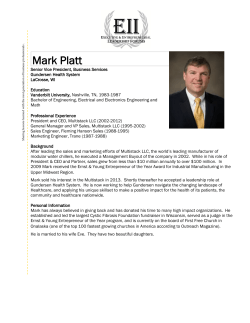
Read more... - American Bar Association
Tax Geek Tips You Ought To Know A PUBLICATION OF THE BALLARD SPAHR TAX GROUP OCTOBER 2014 THE LESSONS OF UP-C IPOS FOR EVERYONE The Up-C IPO structure (sometimes called Supercharged IPO structure, or the barnesandnoble.com structure) is a method of taking a company public using an LLC. Use of this structure allows the pre-IPO owners to receive a higher purchase price for their interests than they would have received if the IPO had been undertaken using a traditional structure. You may say to yourself, I’m neither the owner of a company that will go public, nor an adviser to one, so why would I care? The answer is that the Up-C IPO structure offers several important lessons to anyone engaged in, or advising as to, business transactions: Lesson 1: Using a structure that allows buyers to receive a tax benefit often allows sellers the ability to negotiate to receive a higher purchase price. Lesson 2: There are few circumstances in which an LLC would not make sense as the initial choice of entity. Lesson 3: The effect of taxes on the bottom line (i.e., dollars paid or dollars received) is best realized when discussed early and understood by the non-tax advisers. Traditional IPO Until relatively recently, it was commonly accepted that companies desiring to go public should be C corporations.1 1 While it may be possible for interests in an LLC to be publicly traded, the capital markets generally expect publicly traded companies to be state law corporations. In addition, in most cases, the tax advantages typically associated with LLCs will be lost because a publicly traded LLC will be treated for U.S. federal income tax purposes as though it were a corporation (subject to some exceptions). Diagram of Traditional IPO Structure: Pre-IPO owners sell stock to public PRE-IPO OWNERS SHARES OF IPO CO CASH End result PRE-IPO OWNERS PUBLIC IPO CO PUBLIC IPO CO Up-C IPO The Up-C IPO structure2 is premised on the following basic principles of tax law: • Buyers want a tax basis step-up with respect to the assets of the business they are purchasing. • Tax deductions resulting from a stepped-up tax basis are tax benefits with a value. • Buyers will pay more for a company with a stepped-up tax basis in assets than for one with no such stepped-up tax basis. Diagram of Up-C IPO Structure: Beginning structure Simplified steps End result PUBLIC PRE-IPO OWNERS PRE-IPO OWNERS LLC SUB 2 MEMBERSHIP INTERESTS IN LLC SUB CASH LLC SUB IPO CO PUBLIC IPO CO LLC SUB The Up-C IPO structure gets its name from the UPREIT structure for REITS. In the early ‘90s, the real estate industry began placing partnership under REITS when taking the REIT public. The Up-C IPO is similarly based on a structure under which an LLC/partnership is placed under IPO Co. The public shareholders purchase their shares in IPO Co for cash. IPO Co uses the proceeds received in the IPO to purchase interests in LLC Sub from the pre-IPO owners. LLC Sub has a “Section 754 election” in place—which generally means that a buyer that purchases interests in it is able to obtain tax deductions associated with a stepped-up tax basis. The pre-IPO owners need not sell all their interests in LLC Sub at the time of the IPO in order to convey tax benefits to IPO Co.3 This feature offers a major tax deferral benefit for the pre-IPO owners over what would generally be available to them as C corporation shareholders.4 Typically, the pre-IPO owners enter a tax receivables agreement (TRA), pursuant to which IPO Co pays them 85 percent of the tax benefits realized relating to the tax basis step-up. Further Consideration of Lessons for All: Lesson 1: Using a structure that allows buyers to receive a tax benefit often allows sellers the ability to negotiate to receive a higher purchase price. It is estimated that TRA payments associated with an Up-C IPO can result in an additional 10 to 20 percent in cash proceeds to the pre-IPO owners over the life of the sale. Outside the IPO context, any time a buyer receives a stepped-up tax basis, it is due in part to the fact that the seller owned the business in a manner or structure that allowed a stepped-up tax basis to be achieved upon purchase. This should not be overlooked in discussions of the purchase price to be paid to sellers. Lesson 2: There are few circumstances in which an LLC would not make sense as the initial choice of entity. While there are some circumstances in which a C corporation may make sense (for example, as a vehicle for investment by a non-U.S. investor), there are very few such circumstances. Generally, a purchase/sale of an LLC will result in a stepped-up tax basis to the buyer. By contrast, there are limited circumstances where this is true of a purchase/sale of an interest in a corporation. Furthermore, converting from an LLC to a corporation may often be done without triggering income taxes. This is not true of a conversion of a corporation to an LLC. Lesson 3: The effect of taxes on the bottom line (i.e., dollars paid or dollars received) is best realized when discussed early and understood by the non-tax advisers. Up-C IPOs are based on relatively straightforward and settled tax law. One of the first IPOs using this structure involved barnesandnoble.com in 1999. However, it wasn’t until a few years later that the Up-C IPO structure became more commonly used. There likely are many reasons for the delay in the structure being used on a more frequent basis. That said, in the authors’ experiences, using tax considerations to negotiate better business terms is most successful when tax lawyers are involved in discussions sooner rather than later, and further where the non-tax advisers and relevant parties have a clear understanding of the tax considerations. 3 IPO Co obtains a stepped-up tax basis (which results in tax deductions) in the shares of LLC Sub’s assets upon its initial purchase of any LLC Sub interest in the IPO, and upon any subsequent exchange of LLC Sub’s units for IPO shares. 4 The units they own in LLC Sub are exchangeable for shares of IPO Co at any time they choose. While the future exchange will be taxable, this feature permits tax deferral without the tax complexity of an installment sale. The above discussion addresses the tax issues and structuring involved only at a high level. Please consult members of the Ballard Spahr Tax Group for further discussion. Saba Ashraf Partner ashrafs@ballardspahr.com Tel 678.420.9372 Atlanta Christopher A. Jones Associate jonesc@ballardspahr.com Tel 215.864.8424 Philadelphia Jeffrey R. Davine Partner davine@ballardspahr.com Tel 303.299.7312 Denver Wendi L. Kotzen Partner kotzenw@ballardspahr.com Tel 215.864.8305 Philadelphia Wayne R. Strasbaugh Partner strasbaugh@ballardspahr.com Tel 215.864.8328 Philadelphia Atlanta | Baltimore | Bethesda | Denver | Las Vegas | Los Angeles | New Jersey | New York | Philadelphia | Phoenix | Salt Lake City | San Diego Washington, DC | Wilmington | www.ballardspahr.com
© Copyright 2025










